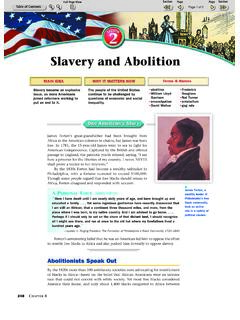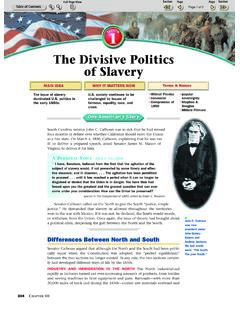Transcription of Religion Sparks Reform - Caggia Social Studies
1 One American's StoryReligion SparksReformWhen Charles Grandison Finneypreached, his listenersshrieked, moaned, and fainted. The most famous preacher ofthe era, Finney inspired emotional religious faith, using aspeaking style that was as much high drama as prayer or ser-mon. Converted at the age of 29, Finney traveled by horse-back to deliver his message. Finney seated the most likelyconverts in his audiences on a special anxious bench, wherehe could fasten his eyes upon them. He lectured on the depthof the conversion PERSONALVOICECHARLES GRANDISON FINNEY I know this is all so much algebra to those who have never felt to those who have experienced the agony of wrestling, prevailingprayer, for the conversion of a soul, you may depend upon it, that soul.
2 Appears as dear as a child is to the mother who brought it forth with pain. Lectures on Revivals of ReligionsThe convert s duty was to spread the word about personal salvation to religious activism or evangelism was part of an overall era of Reform thatstarted in the 1830s. Reforms of the period included women s rights, school Reform ,and abolition , the movement to outlaw slavery . All of these movements emergedas responses to rapid changes in American society such as early industrial growth,increasing migration and immigration, and new means of Second Great AwakeningMuch of the impulse toward Reform was rooted in the revivals of the broad religious movement that swept the United States after 1790.
3 Known as theSecond Great and his contemporaries were participants in 240 CHAPTER8 Terms & NamesTerms & NamesMAIN IDEAMAIN IDEAWHY IT MATTERS NOWWHY IT MATTERS NOW Charles GrandisonFinney Second GreatAwakening revival Ralph WaldoEmerson transcendentalism Henry DavidThoreau civil disobedience utopiancommunity Dorothea DixA renewal of religioussentiment known as theSecond Great Awakening inspired a host of modern Social and politicalreform movements grew out ofthe Reform movements of 19th-century America. Charles GrandisonFinney p0240-245aspe-0208s1 10/16/02 4:01 PM Page 240 AReforming American Society241the Second Great Awakening. These preachers rejected the18th-century Calvinistic belief that God predeterminedone s salvation or damnation whether a person went toheaven or hell.
4 Instead, they emphasized individual respon-sibility for seeking salvation, and they insisted that peoplecould improve themselves and ideas current in the early 19th century pro-moted individualism and responsibility, similar to theemphasis of Jacksonian democracy on the power of thecommon citizen. Christian churches split over these ideas,as various denominations competed to proclaim the mes-sage of a democratic God, one who extends the possibilityof salvation to all people. The forums for their messageswere large gatherings, where some preachers could drawaudiences of 20,000 or more at outdoor a gathering was called a revival,anemotional meeting designed to awaken religious faiththrough impassioned preaching and prayer.
5 A revival mightlast 4 or 5 days. During the day the participants studied theBible and examined their souls. In the evening they heardemotional preaching that could make them cry out, burstinto tears, or tremble with swept across the United States in the early19th century. Some of the most intense revivals took placein a part of western New York known as the burned-overdistrict because of the religious fires that frequently burnedthere. Charles Finney fanned these flames, conductingsome of his most successful revivals in Rochester, New Rochester revivals earned Finney the reputation of thefather of modern revivalism. Revivalism had a strong impact on the to one estimate, in 1800 just 1 in 15 Americans belonged to a church,but by 1850, 1 in 6 was a member.
6 THE AFRICAN-AMERICAN CHURCHThe Second Great Awakening also broughtChristianity on a large scale to enslaved African Americans. There was a strongdemocratic impulse in the new churches and a belief that all people black orwhite belonged to the same God. Thus,the camp meetings and the new Baptistor Methodist churches were open toboth blacks and whites. Slaves inthe rural South though theywere segregated in pews of theirown worshiped in the samechurches, heard the same ser-mons, and sang the same hymnsas did the slave owners. EnslavedAfrican Americans, however,interpreted the Christian mes-sage as a promise of freedom fortheir the East, many free AfricanAmericans worshiped in separateblack churches, like Richard Allen sBethel African Church in Philadelphia,which by 1816 would become the AfricanThis early-19th-century traydepicts LemuelHaynes preachingin his IDEAMAIN IDEAAA nalyzingEffectsHow did theSecond GreatAwakeningrevolutionize theAmerican religioustradition?
7 MODERN REVIVALISME vangelical Christianity reemergedin several different religious organ-izations in the late 20th centur example is the ChristianCoalition, a religiously based citizen-action organization withalmost 2 million with the Second GreatAwakening, members of thesereligious organizations often areactive in political movements thatspring from personal religious be-liefs. Indeed, some of the organi-zations use television much likeFinney used the revival meetingto encourage believers to act ontheir A. Answer It taught thatindividualresponsibilitywas the way to wasone effect of theSecond 10/16/02 4:01 PM Page 241 Methodist Episcopal Church. Allen inspired his congregation to strengthen itsfaith as well as to fight against PERSONALVOICERICHARD ALLEN Our only design is to secure to ourselves, our rights and privileges to regulateour affairs temporal and spiritual, the same as if we were white people, and toguard against any oppression which might possibly arise from the improper preju-dices or administration of any individual having the exercise of Discipline over us.
8 Quoted in Segregated SabbathsMembership in the African Methodist Episcopal Church grew rapidly. Itbecame a political, cultural, and Social center for African Americans, providingschools and other services that whites denied the African-American church developed a political voice andorganized the first black national convention, held in Philadelphia in September1830. Richard Allen convened the meeting, in which partici-pants agreed to explore the possible settlement of free AfricanAmericans and fugitive slaves in Canada. Allen s conventionwas the first of what would become an annual convention offree blacks in the North. The African-American church gave itsmembers a deep inner faith, a strong sense of community and the spiritual support to oppose and ReformsMany reformed-minded individuals sought an alternative totraditional Religion but found revivalism too public a forumfor religious the mid-1800s, some Americanswere taking new pride in their emerging culture.
9 RalphWaldo emerson ,a New England writer, nurtured this led a group practicing transcendentalism aBMAIN IDEAMAIN IDEABS ummarizing How did theAfrican-Americanchurch support itsfollowers?History ThroughHistory ThroughA VIEW OF THE MOUNTAINPASS CALLED THE NOTCH OFTHE WHITE MOUNTAINS(CRAWFORD NOTCH)(1839)This painting by Thomas Cole isan example of the Hudson Riverschool. Like the transcendental-ists, its painters celebrated thebeauty of the American land-scape, and the truth found inpersonal emotion. What relationship betweenhumans and nature does Cole'spainting portray?B. Answer Bygiving its mem-bers a sense ofcommunity, aninner faith, andthe spiritual andpolitical supportto 10/16/02 4:01 PM Page 242philosophical and literary movement that emphasized living a simple life and cel-ebrated the truth found in nature and in personal emotion and imagination.
10 Exalting the dignity of the individual, the transcendentalists spawned a liter-ary movement that stressed American ideas of optimism, freedom, and self - reliance . emerson s friend Henry David Thoreauput the idea of self -relianceinto practice. Abandoning community life, he built himself a cabin on the shoreof Walden Pond near Concord, Massachusetts, where he lived alone for two years.(See Literature of the Transcendentalists, page 246.) In Walden(1854), Thoreauadvised readers to follow their inner PERSONALVOICEHENRY DAVID THOREAU I learned this, at least, by my experiment; that if one advances confidently in thedirection of his dreams, and endeavors to live the life which he has imagined, hewill meet with a success unexpected in common hours.









